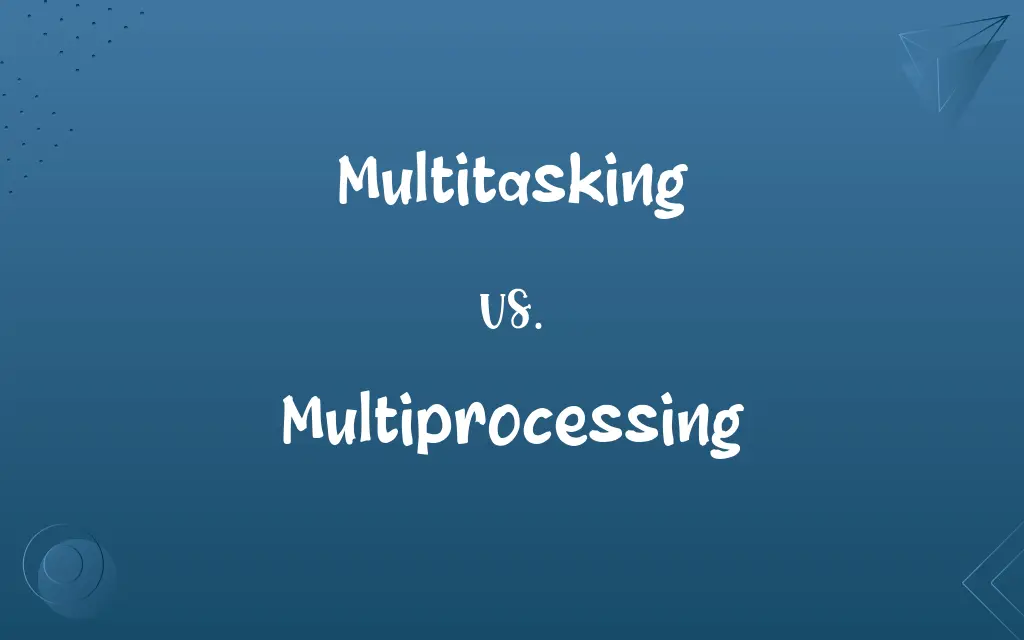Multitasking vs. Multiprocessing: Know the Difference

By Shumaila Saeed || Published on February 22, 2024
Multitasking involves a single CPU managing multiple tasks simultaneously, while multiprocessing uses multiple CPUs to run tasks concurrently.

Key Differences
Multitasking is a method where a single CPU executes several tasks by switching between them, giving the illusion of simultaneous processing. This is achieved through task scheduling, where the CPU allocates time slices to each task. Multiprocessing, on the other hand, refers to the use of two or more CPUs within a single computer system to process tasks. Here, each processor can execute a different task at the same time, truly enabling concurrent processing.
Shumaila Saeed
Feb 22, 2024
In multitasking, tasks share the same CPU resources, and the efficiency depends on the CPU's ability to switch rapidly between tasks. It is widely used in personal computing where tasks like running applications and background processes occur concurrently. Multiprocessing is more common in systems requiring high computational power, as multiple CPUs can handle complex, resource-intensive tasks simultaneously, significantly improving performance.
Shumaila Saeed
Feb 22, 2024
Multitasking can be either preemptive or cooperative. In preemptive multitasking, the operating system decides when to switch tasks, while in cooperative multitasking, the tasks control the switching. Multiprocessing systems can be symmetrical or asymmetrical. In symmetrical systems, all CPUs are equal and share tasks equally, whereas in asymmetrical systems, a primary CPU controls the system, and secondary CPUs handle specific tasks.
Shumaila Saeed
Feb 22, 2024
The primary advantage of multitasking is its efficiency in utilizing CPU resources and enhancing the user experience in a single-CPU environment. However, it can lead to issues like resource contention and can suffer from reduced performance when too many tasks are running. Multiprocessing excels in raw processing power and is better suited for applications like scientific computing and data analysis, where tasks can be parallelized effectively.
Shumaila Saeed
Feb 22, 2024
Multitasking requires careful management of resources, such as memory and process priorities, to ensure smooth operation. It's effective for general-purpose computing where multiple, less resource-intensive tasks are performed. Multiprocessing involves more complexity in terms of hardware and software architecture but provides a scalable solution for processing-intensive tasks across multiple CPUs, enhancing throughput and efficiency in high-end computing environments.
Shumaila Saeed
Feb 22, 2024
ADVERTISEMENT
Comparison Chart
CPU Usage
Utilizes one CPU to handle multiple tasks
Employs multiple CPUs to execute tasks concurrently
Shumaila Saeed
Feb 22, 2024
Task Management
Switches between tasks to simulate simultaneous execution
Performs multiple tasks simultaneously in reality
Shumaila Saeed
Feb 22, 2024
Application
Ideal for general-purpose personal computing
Suited for high-performance and resource-intensive tasks
Shumaila Saeed
Feb 22, 2024
Efficiency
Efficient in resource utilization in a single CPU
High efficiency in processing power with multiple CPUs
Shumaila Saeed
Feb 22, 2024
Complexity
Relatively simpler in managing a single CPU
More complex, involving multiple CPUs and synchronization
Shumaila Saeed
Feb 22, 2024
ADVERTISEMENT
Multitasking and Multiprocessing Definitions
Multitasking
Performing several tasks in quick succession.
In a busy workday, multitasking involves answering calls, replying to emails, and attending meetings.
Shumaila Saeed
Jan 13, 2024
Multiprocessing
The use of two or more CPUs in a computer system to process tasks concurrently.
The server's multiprocessing capability enabled it to handle thousands of requests per second.
Shumaila Saeed
Jan 13, 2024
Multitasking
The ability of a system to manage more than one task at a time.
While writing a report, she was multitasking by also checking her emails.
Shumaila Saeed
Jan 13, 2024
Multiprocessing
Parallel processing of tasks using multiple processors.
With multiprocessing, the data analysis software finished computations in half the usual time.
Shumaila Saeed
Jan 13, 2024
Multitasking
The process of interleaving multiple tasks to maximize resource usage.
Her multitasking skills were evident as she simultaneously managed the customer service chat and database updates.
Shumaila Saeed
Jan 13, 2024
ADVERTISEMENT
Multiprocessing
Utilizing multiple CPUs for improved computational efficiency.
The research lab's multiprocessing setup facilitated faster simulation of complex scientific experiments.
Shumaila Saeed
Jan 13, 2024
Multitasking
Simultaneous execution of multiple tasks by rapidly switching between them.
The operating system's multitasking capability allows running a virus scan while browsing the web.
Shumaila Saeed
Jan 13, 2024
Multiprocessing
Execution of multiple processes across different processors simultaneously.
Multiprocessing in the new gaming console allowed for more complex and realistic game environments.
Shumaila Saeed
Jan 13, 2024
Multitasking
Juggling a variety of tasks within a limited timeframe.
He was multitasking by balancing his budget while managing his team remotely.
Shumaila Saeed
Jan 13, 2024
Multiprocessing
A system's ability to divide tasks among several CPUs.
Their new multiprocessing architecture significantly improved the performance of their computational models.
Shumaila Saeed
Jan 13, 2024
Multitasking
The concurrent operation by one central processing unit of two or more processes.
Shumaila Saeed
Jan 12, 2024
Multiprocessing
A method of computing in which different parts of a task are distributed between two or more similar central processing units, allowing the computer to complete operations more quickly and to handle larger, more complex procedures.
Shumaila Saeed
Jan 12, 2024
Multitasking
The engaging in more than one activity at the same time or serially, switching one's attention back and forth from one activity to another.
Shumaila Saeed
Jan 12, 2024
Multitasking
(computing) The simultaneous execution of multiple tasks (programs) under the control of an interrupt-driven operating system.
Shumaila Saeed
Jan 12, 2024
Multitasking
The practice or capability of handling more than one task at the same time.
Shumaila Saeed
Jan 12, 2024
Repeatedly Asked Queries
How does multitasking work?
Multitasking works by the CPU allocating time slices to each task, rapidly switching among them to give the appearance of parallel processing.
Shumaila Saeed
Feb 22, 2024
What are the types of multitasking?
The two main types of multitasking are preemptive and cooperative.
Shumaila Saeed
Feb 22, 2024
What is the difference between symmetrical and asymmetrical multiprocessing?
Symmetrical multiprocessing uses identical CPUs sharing tasks equally, while asymmetrical has a primary CPU directing secondary CPUs.
Shumaila Saeed
Feb 22, 2024
What is the key benefit of multitasking?
The key benefit of multitasking is efficient utilization of CPU resources in handling multiple tasks.
Shumaila Saeed
Feb 22, 2024
What is multitasking?
Multitasking is a technique where a single CPU executes multiple tasks by quickly switching between them.
Shumaila Saeed
Feb 22, 2024
What is multiprocessing?
Multiprocessing refers to the use of multiple CPUs in a computer system to process tasks simultaneously.
Shumaila Saeed
Feb 22, 2024
Can multitasking lead to reduced performance?
Yes, multitasking can lead to reduced performance if too many tasks overload the CPU.
Shumaila Saeed
Feb 22, 2024
Can multitasking occur in multiprocessing systems?
Yes, multitasking can occur within each CPU of a multiprocessing system.
Shumaila Saeed
Feb 22, 2024
Is multiprocessing suitable for personal computing?
While possible, multiprocessing is generally overkill for standard personal computing needs.
Shumaila Saeed
Feb 22, 2024
What is the main advantage of multiprocessing?
The main advantage of multiprocessing is its ability to increase computational power and handle complex tasks simultaneously.
Shumaila Saeed
Feb 22, 2024
How do multiprocessing systems handle data sharing?
Multiprocessing systems use complex algorithms and memory management techniques to handle data sharing among CPUs.
Shumaila Saeed
Feb 22, 2024
Is multitasking always efficient?
Multitasking is efficient for managing multiple light tasks but can be inefficient if tasks are too demanding.
Shumaila Saeed
Feb 22, 2024
Can multitasking handle resource-intensive tasks well?
Multitasking is less suited for very resource-intensive tasks compared to multiprocessing.
Shumaila Saeed
Feb 22, 2024
Does multiprocessing require special software?
Yes, multiprocessing requires an operating system and software capable of managing multiple CPUs.
Shumaila Saeed
Feb 22, 2024
How does multiprocessing improve performance?
Multiprocessing improves performance by parallelizing tasks, allowing them to be processed faster.
Shumaila Saeed
Feb 22, 2024
Are there specific applications where multiprocessing is essential?
Multiprocessing is essential in applications like scientific computing, data analysis, and high-end video processing.
Shumaila Saeed
Feb 22, 2024
What impact does multitasking have on a system's resources?
Multitasking can strain a system's resources like memory and CPU if not managed correctly, leading to potential slowdowns.
Shumaila Saeed
Feb 22, 2024
Is multitasking limited to computers?
No, multitasking is a concept that can apply to any system that handles multiple tasks, including humans.
Shumaila Saeed
Feb 22, 2024
What are the challenges of implementing multiprocessing?
The challenges include increased complexity, higher costs, and the need for specialized software and hardware.
Shumaila Saeed
Feb 22, 2024
Can all computers perform multitasking?
Most modern computers can perform multitasking, but the efficiency varies based on the CPU and system design.
Shumaila Saeed
Feb 22, 2024
Share this page
Link for your blog / website
HTML
Link to share via messenger
About Author
Written by
Shumaila SaeedShumaila Saeed, an expert content creator with 6 years of experience, specializes in distilling complex topics into easily digestible comparisons, shining a light on the nuances that both inform and educate readers with clarity and accuracy.








































































